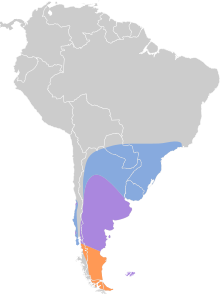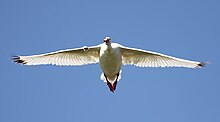Coscoroba swan
| Coscoroba swan | |
|---|---|

| |
| Scientific classification | |
| Domain: | Eukaryota |
| Kingdom: | Animalia |
| Phylum: | Chordata |
| Class: | Aves |
| Order: | Anseriformes |
| Family: | Anatidae |
| Genus: | Coscoroba Reichenbach,1853 |
| Species: | C. coscoroba
|
| Binomial name | |
| Coscoroba coscoroba (Molina,1782)
| |

| |
Thecoscoroba swan(Coscoroba coscoroba) is a species ofwaterfowlin the subfamilyAnserinaeof the familyAnatidae.[3][4]It is found inArgentina,Bolivia,Brazil,Chile,Paraguay,Uruguay,and theFalkland Islands.[5]
Taxonomy and systematics
[edit]The coscoroba swan's placement within the family Anatidae is not fully agreed upon, with a 2014 genetic study positing a phylogenetic relationship between this species and theCape Barren goose(Cereopsis novaehollandiae).[6]BirdLife International'sHandbook of the Birds of the Worldhas adopted this approach and places the coscoroba swan and Cape Barren goose together in the tribe Cereopsini, which it places asbasaltoCygnusand all other geese.[4]However, the South American Classification Committee of theAmerican Ornithological Society,theInternational Ornithological Committee(IOC), and theClements taxonomytreat the Cape Barren goose as basal to other geese, which themselves precede the coscoroba and other swans in a linear sequence. Even those three systems differ, with the IOC placing the coscoroba beforeCygnusand the other two after it in their lists.[7][3][8]
The coscoroba swan is the only member of the genusCoscorobaand has nosubspecies.[3]

Description
[edit]The coscoroba swan is a medium-large sized waterfowl, but smaller than thetrue swans,at 90 to 115 cm (35 to 45 in) long with a wingspan of about 155 cm (61 in). Males weigh 3.8 to 5.4 kg (8.4 to 12 lb) and females 3.1 to 4.5 kg (6.8 to 9.9 lb). Their appearance is considered to be slightly unusual, being intermediate between that of geese and true swans. They have completely feathered faces—unusual for true swans—and their feet are located directly under their bodies, enabling the coscoroba swan to walk more efficiently than the “waddling” of most waterfowl.[9]Physically, coscoroba swans have been compared to theAmerican Pekinduck, albeit larger and with darker, redder bills and feet (Pekin ducks have bright orange bills and feet).[10]The sexes have the same plumage; upon hatching, the chicks have blue-grey bills and feet and black striping running down the length of their bodies (to aid in camouflage from predators), with this eventually fading by about eight months of age. The adults are completely white, except for black tips to the outer sixprimary feathers,though this black is often barely visible on the closed wing unless the bird is in flight.[11][12]
Distribution and habitat
[edit]The coscoroba swan is a year-round resident of central Argentina and along the Uruguay-southern Brazil coast. It also breeds but does not winter from southern Chile and Argentina south toTierra del Fuegoand occasionally to the Falkland Islands. In winter its range extends north to central Chile, northern Argentina, Paraguay, Uruguay, and southern Brazil. It has been recorded as avagrantin Bolivia and at several locations in Brazil north of its usual limit. The coscoroba swan inhabits well-vegetated lagoons, freshwater swamps, and sometimes human-made reservoirs. It is mainly a bird of the lowlands, though there are scattered records as high as 1,300 m (4,300 ft) and at least one at 2,000 m (6,600 ft).[11][5]
Behavior
[edit]Feeding
[edit]The coscoroba swan's diet has not been studied in detail, but it apparently feeds on aquatic and some terrestrial plants, small aquatic invertebrates, and small fish. It forages mainly while swimming or wading in shallow water and in contrast to other swans seldom upends. It also grazes on land. It often feeds withblack-necked swans(Cygnus melanocoryphus).[11]
Breeding
[edit]The coscoroba swan breeds in the local spring, which is May to October in northern Argentina, July to December in Chile, and July and August in southern Brazil. The species forms long-term pair bonds. Its nest is a mound of vegetation lined with soft grass constructed by both members of a pair on a small islet, partially floating in a reedbed or long grass close to water. Theclutchsize is four to nine oval eggs that weigh about 167 g (5.9 oz) with dimensions of about 88 by 60 mm (3.5 by 2.4 in). Males guard females during the incubation period of about 35 days. Both parents care for the young through fledging at 14 weeks and beyond, sometimes until they are a year old. In captivity, coscoroba swans can live 20 years.[11]
Vocalization
[edit]The coscoroba swan makes anonomatopoeic"cos-cor-oo",usually as a threat to intruders. They also make a" monosyllabic hooting note "as a contact call between mates. Immature birds make" loud chirps and trills ".[11]
Status
[edit]TheIUCNhas assessed the coscoroba swan as being of Least Concern. It has a large range and its estimated population of 6700 to 17,000 mature individuals is believed to be stable. No immediate threats have been identified.[1]The species' population varies dramatically at different parts of its range, being fairly common in Argentina, uncommon in Paraguay and Uruguay, rare in Chile, and uncertain in Brazil. The "[g]reatest threat seems to be loss of temperate marsh habitats due to urbanization and agricultural developments".[11]
Gallery
[edit]-
Juveniles inRio Grande do Sul,Brazil
-
Bath taking atWeltvogelpark Walsrode
-
Swimming
-
AtBerlin Zoo,Germany
References
[edit]- ^abBirdLife International (2016)."Coscoroba SwanCoscoroba coscoroba".IUCN Red List of Threatened Species.2016:e.T22679866A92832574.doi:10.2305/IUCN.UK.2016-3.RLTS.T22679866A92832574.en.Retrieved28 September2022.
- ^"Appendices | CITES".cites.org.Retrieved2022-01-14.
- ^abcGill, F.; Donsker, D.; Rasmussen, P., eds. (August 2022)."Screamers, ducks, geese, swans".IOC World Bird List.v 12.2.RetrievedAugust 9,2022.
- ^abHBW and BirdLife International (2021) Handbook of the Birds of the World and BirdLife International digital checklist of the birds of the world. Version 6. Available at:http://datazone.birdlife.org/userfiles/file/Species/Taxonomy/HBW-BirdLife_Checklist_v6_Dec21.zipretrieved August 7, 2022
- ^abRemsen, J. V., Jr., J. I. Areta, E. Bonaccorso, S. Claramunt, A. Jaramillo, D. F. Lane, J. F. Pacheco, M. B. Robbins, F. G. Stiles, and K. J. Zimmer. Version 24 July 2022. Species Lists of Birds for South American Countries and Territories.https://www.museum.lsu.edu/~Remsen/SACCCountryLists.htmretrieved July 24, 2022
- ^Rodrigues, B.S.et al.(2014)Chromosomal studies onCoscoroba coscoroba(Aves: Anseriformes) reinforce theCoscoroba–Cereopsisclade.Biological Journal of the Linnean Society,111: 274–279.
- ^Remsen, J. V., Jr., J. I. Areta, E. Bonaccorso, S. Claramunt, A. Jaramillo, D. F. Lane, J. F. Pacheco, M. B. Robbins, F. G. Stiles, and K. J. Zimmer. Version 24 July 2022. A classification of the bird species of South America. American Ornithological Society.https://www.museum.lsu.edu/~Remsen/SACCBaseline.htmretrieved July 24, 2022
- ^Clements, J. F., T. S. Schulenberg, M. J. Iliff, S. M. Billerman, T. A. Fredericks, J. A. Gerbracht, D. Lepage, B. L. Sullivan, and C. L. Wood. 2021. The eBird/Clements checklist of Birds of the World: v2021. Downloaded fromhttps://www.birds.cornell.edu/clementschecklist/download/Retrieved August 25, 2021
- ^"Keeper Talks - Coscoroba Swan".Sylvan Heights Bird Park (YouTube channel).Sylvan Heights Bird Park. 10 April 2020.Retrieved22 June2023.
- ^"Keeper Talks - Coscoroba Swan".Sylvan Heights Bird Park (YouTube channel).Sylvan Heights Bird Park. 10 April 2020.Retrieved22 June2023.
In this Keeper Talk,aviculturistJessica introduces one of the more unusual waterfowl species. Is it really a swan? Is it a goose? Or is it more like a duck? Watch the video to find out!
- ^abcdefCarboneras, C. and G. M. Kirwan (2020). Coscoroba Swan (Coscoroba coscoroba), version 1.0. In Birds of the World (J. del Hoyo, A. Elliott, J. Sargatal, D. A. Christie, and E. de Juana, Editors). Cornell Lab of Ornithology, Ithaca, NY, USA.https://doi.org/10.2173/bow.cosswa1.01retrieved September 28, 2022
- ^Bouglouan, Nicole."Coscoroba Swan".oiseaux-birds.com.RetrievedSeptember 28,2022.
External links
[edit] Media related toCoscoroba coscorobaat Wikimedia Commons
Media related toCoscoroba coscorobaat Wikimedia Commons








